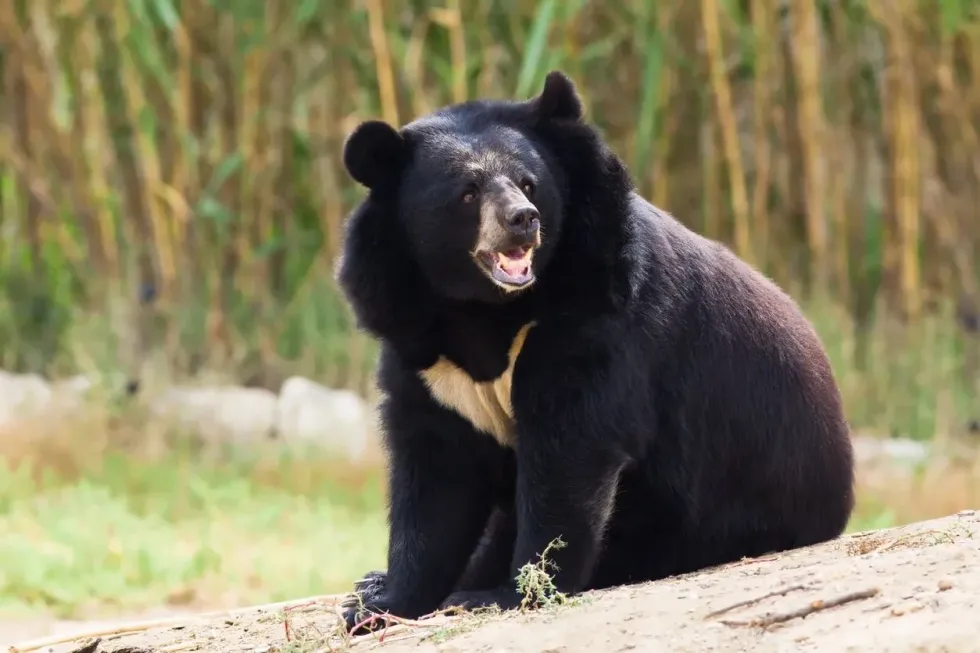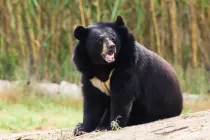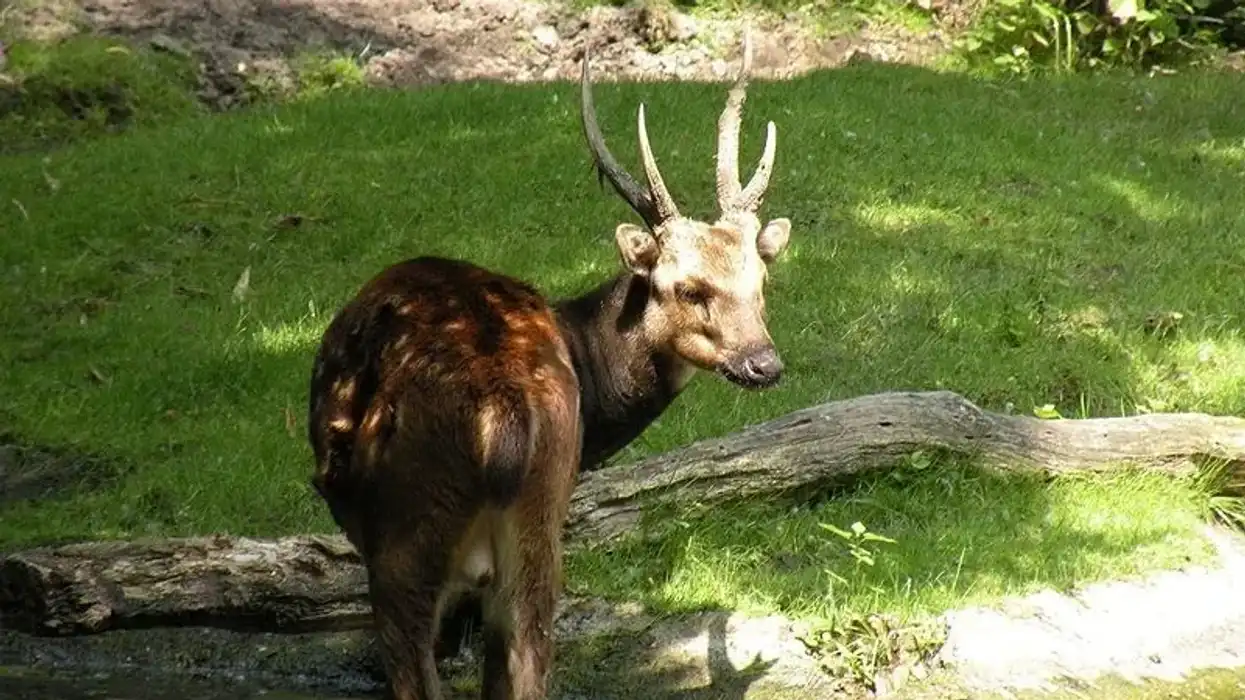Fun Asiatic Black Bear Facts For Kids
Content
- What type of animal is an Asiatic black bear?
- What Class Of Animal Does An Asiatic Black Bear Belong To?
- How Many Asiatic Black Bears Are Left?
- Where Does An Asiatic Black Bear Live?
- What Is An Asiatic Black Bear's Habitat?
- Who Do Asiatic Black Bears Live With?
- How Long Does An Asiatic Black Bear Live?
- How Do They Reproduce?
- What Is Their Conservation Status?
- What do Asiatic black bears look like?
- How cute are they?
- How do they communicate?
- How Big Is An Asiatic Black Bear?
- How Fast Can An Asiatic Black Bear Move?
- How Much Does An Asiatic Black Bear Weigh?
- What Are Their Male And Female Names Of The Species?
- What Would You Call A Baby Asiatic Black Bear?
- What Do They Eat?
- Are They Dangerous?
- Would They Make A Good Pet?
- Did you know...
- Why Are Asiatic Black Bears Endangered?
- How Big Do Asiatic Black Bears Get?
The Asiatic black bear (Ursus thibetanus) is a species from the Ursidae family. They have black fur and a distinct crescent-shaped white mark on their chests. This mark can help anyone differentiate between the American black bear and the Asian black bears.
The Asian black bear has seven subspecies. Though there are some differences between the subspecies, they are similar to each other in looks and behavior. The Ussuri black bear is the largest subspecies.
The Asiatic black bears are native to Asia. They can be found in southern and northeastern China, Northern parts of India, Pakistan, Honshu, and Shikoku islands of Japan, Taiwan, and North Korea.
Asian black bears are omnivorous and have a diet that consists of fruits, berries, insects, beehives, small birds, and animals. They are diurnal animals by nature but show nocturnal behavior when they are around humans. They are one of the biggest arboreal animals in the world and are excellent climbers.
Their territories usually cover 1-2 square km areas. If they have sufficient food in that area, they do not need to extend their areas.
If you like our article about Asian black bears, don't miss the other ones that are equally enthralling like the leopard seal and the fennec fox.
Interesting Asiatic Black Bear Facts
What type of animal is an Asiatic black bear?
The Asiatic black bear (Ursus thibetanus) or the Asian black bear is medium-sized. They are native to Asia. They are also called the moon bear or white chested bear. Selenarctos thibetanus is another scientific name that may be used.
What Class Of Animal Does An Asiatic Black Bear Belong To?
The Asiatic Black Bear (Ursus Thibetanus) Belongs To The Mammalia class Of The Animalia Kingdom.
How Many Asiatic Black Bears Are Left?
Asiatic Black Bears Are Vulnerable. In the entire world, there are only about 50,000 Asiatic black bears left. Their population is declining as a result of widespread poaching and habitat loss from deforestation. They Are a Vulnerable Species.
They Are Mostly Found In Southeast Asia. They Can Be Easily Found In The Mountainous Areas Of Pakistan, Afghanistan, India, Vietnam, And Southern And Northeastern China. But They Mostly Live In The Himalayan Mountain Ranges. They Are Also Sparsely Found In Eurasia.
Where Does An Asiatic Black Bear Live?
As Natives Of Asia, The Asiatic Black Bears Live In The Mountain Ranges And Forests Of Asia And Eurasia. They Can Be Found In The Central And Southern Part Of China, A Few Places In Japan, India, North Korea And Pakistan. The Himalayas And Other Asian Mountainous Forest Ranges Are Their Natural Habitats.
Some Asian Black Bears Also Live In Zoos In Various Countries. But It Is A Wild Animal. They Travel To Higher Altitudes In Summer And Descend During The Winter.
What Is An Asiatic Black Bear's Habitat?
The Asiatic Black Bears Usually Live In The Mountainous Forests Of Asia And Eurasia. They Are Found In Moist Mountains And Dense Forests Of China, Japan, Pakistan, India, And Other Asian Countries.
Being Arboreal Animals, They Tend To Feel Comfortable Amongst Trees And Dense Jungles. They Have Migratory Tendencies And Climb To Higher Altitudes During Summer.
And Climb Down Before Winter. They Climb Up To 11,480 Ft-12,000 Ft (3,499 m -3,700 Meters) In The Summer, Where They Live For That Time. In The Winter, They Descend To 5,000 Ft (1,500 Meters).
They Are Generally Mostly Found In Deciduous Forests And Mixed Forests. They Are Found In Certain Parts Of Pakistan, India, China, North Korea, Japan, Bangladesh, Myanmar, And Even In Russia.
The White-Chested Bears Usually Like Living Amongst Trees As That Is Their Most Comfortable Living Condition And Hunting Ground. They Are Excellent Climbers, And Trees Keep Them Safe From Predators.
Who Do Asiatic Black Bears Live With?
Asiatic Black Bears Are Not Pack Animals. They Prefer Living On Their Own. But Their Families Sometimes Consist Of One Male And One Female Adult And Their Offsprings.
Though Not Much Is Known About The Habits Of These Bears, It Is Speculated That They Prefer Living Alone In The Wild. The Asiatic Black Bear Cubs Gain Independence At About Three Years Of Age. Until Then, They Mostly Live With Their Parents.
How Long Does An Asiatic Black Bear Live?
In The Wild, The Asiatic Black Bear's Average Lifespan Is 25 Years. But In Captivity, Their Lifespan Largely Increases To About 30-33 Years. The Oldest Asiatic Black Bear Who Died In Captivity Was 44 Years Old.
This Is Due To The Lack Of Predators And Poachers. In Captivity, They Also Get Better Treatment For Their Illnesses. This Is Why An Average Asiatic Black Bear Who Lives In A Zoo Usually Has A Few More Years To Its Life.
How Do They Reproduce?
Belonging To The Mammalia Class Of Animals, The Asiatic Black Bears Reproduce Through Mating. They Reach Maturity At Three Years To Four Years Of Age And Begin Mating Around Then.
In The Wild, The Mating Patterns Of Moon Bears Are Varied Throughout Their Habitats. But Largely, Their Mating Season Lasts From June - July r. Their Gestation Period Is Six Months- Eight Months Long.
The Females Give Birth In Late Winter From March - April.
They Give Birth To An Average Of Two Cubs Per Litter, But The Number Of Cubs May Go Up To Even Five In Rare Cases. The Asiatic Black Bear Baby Is Usually Born In Caves Or Hollow Trees.
The Females Give Birth There Because They Are The Safest Places In The Wild, And The Habitat Suits The Newborn Cubs. The Weaning Period Of An Asiatic Black Bear Cub Is About Three To Four Months On Average.
What Is Their Conservation Status?
Asiatic Black Bears Are Vulnerable. With No More Than 50,000 Bears Of The Species Living In The World Today, They Are Definitely Vulnerable. They Have Been Reduced Dramatically In Numbers In The Last Few Years.
This Is Mostly Because Of Rampant Poaching For Their Gallbladder. Some Other Parts Are Used For Unproven Medicinal Purposes.
Their Fur Is Also A Reason For Them Being Hunted. The Population Of Bears Living In The Wild Is Already Vulnerable To Larger Predators, Sickness, Hunting, And Deforestation Just Makes It Even More Difficult For Them. The Asiatic Black Bear Is Listed As Vulnerable In The Iucn Red List.
Asiatic Black Bear Fun Facts
What do Asiatic black bears look like?

Asiatic Black Bears are known for their distinctive features. They have black fur and a light brown nozzle.
Their fur is thick and coarse. Their heads are round, and snouts are usually long. The most distinctive feature of the Asiatic black bear is the crescent-shaped white patch of fur on their chests.
This feature earned them the name of moon bear. They have a strong upper body and sharp claws that help them climb trees. Their ears are proportionately a little longer than most bears.
They have more slender built and smaller skulls than brown bears, but their lower jaws are particularly bigger. Their ears are farther apart than that of American Black Bears.
The Asiatic Black Bear has long and thick limbs as well as broad paws that help them survive in the wild. They are distant relatives of the American black bears.
But the Asiatic black bears have a distinct white mark on their chest that is absent in their American counterparts. They have a short tail that is almost hidden in their coat. The males of the species are usually larger than the females of the species.
How cute are they?
Being wild animals that are large and intimidating, the Asiatic black bears cannot really be classified as cute. Even though they are not human's natural enemies, they might attack if they feel threatened. The Asiatic black bear cubs, on the other hand, are very cute.
How do they communicate?
There are not many conclusive studies as to the communicative abilities of the Asiatic black bears, but it is speculated that they communicate vocally like their other counterparts in the world. They also have a heightened sense of hearing which helps them navigate in the wild.
If an Asian black bear cub is separated from its mother, it will cry for help. The mother, upon hearing the offspring's cries with their excellent sense of hearing, will come to its rescue.
They also communicate visually with their species. For example, the physical behavior of an Asiatic black bear will communicate whether it's dominant or submissive in nature.
Snapping their jaw or making guttural noises can mean they are apprehensive or aggressive. The females have a bond with the offspring that helps them keep them safe from danger.
They also have a very sharp sense of smell that helps them communicate with other Asiatic black bears. By urinating or rubbing against trees, they mark their areas. Even though they mostly walk on all fours, they stand on their hind legs while fighting with other Asiatic black bears.
How Big Is An Asiatic Black Bear?
The Average Length Of An Asiatic Black Bear May Range From 47.2 In - 75 In (120 Cm - 190 Cm). And They May Be 27.5 in - 39.4 in (70 cm - 100 cm) While Standing On All Fours.
While Standing On Their Hind Legs, They Are About 60 In - 66 In (150 Cm- 170 Cm) Tall. This Means, While Standing Upright, They Almost Reach The Height Of An Average Human Being. The Adult Males Of The Moon Bear Species Are Larger Than The Adult Females.
How Fast Can An Asiatic Black Bear Move?
The Asiatic Black Bears May Reach The Top Speed Of 25 Mph (40 Km/H) While Running On All Fours. They Are Also Excellent Climbers, And Their Strong Upper Body Helps Them Climb Trees Even If Their Hind Legs Are Injured. They Can Stand Upright And Walk On Their Hind Legs As Well.
How Much Does An Asiatic Black Bear Weigh?
Asiatic Black Bears Weigh Around 200 Lb -440 Lb (90 Kg - 200 Kg). The Male Asiatic Black Bear Is Larger Than The Female Asiatic Black Bear. They Also Weigh More In The Fall When They Gain Weight Before Going Into Hibernation.
What Are Their Male And Female Names Of The Species?
Both The Adult Males And Females Of The Species Are Called Asiatic Black Bears Or Asian Black Bears. Some Other Names For The Species Are Moon Bear And White-Chested Bear.
What Would You Call A Baby Asiatic Black Bear?
The Baby Asiatic Black Bears Are Called Cubs. Asiatic Black Bear Cubs May Also Be Called Asian Black Bear Cubs Or Moon Bear Cubs.
What Do They Eat?
Asiatic Black Bears Are Omnivorous. Meaning They Eat Both Plants And Meat. Their Regular Diet Consists Of Small Insects, Fruits, Berries, Beehives, Etc.
But Sometimes, They Also Eat Smaller Mammals And Birds. They Mostly Collect Their Food From The Wilderness.
The Asiatic Black Bears Do Not Hibernate For The Most Part, But The Ones That Live In The Far Northern Ranges That Are Really Cold During The Winters Do Hibernate. The Ones That Hibernate Fatten Up With Food Before Hibernation. Since They Are Dependent On Forests For Food, Deforestation Is Making A Dent In Their Population.
Are They Dangerous?
Asiatic Black Bears Are Not Natural Enemies Of Humans. But They Are Dangerous. When They Are Surprised Or Scared, They May Attack Humans.
Would They Make A Good Pet?
The Asiatic Black Bear Is A Wild Animal. Even Though They Are Kept In Captivity To Preserve Their Species Sometimes, They Are Not Good Pets. They Are Often Wary Of Humans, And Even Though They Try To Avoid Human Interaction, They Are Aggressive When They See Humans.
Even More So Than Brown Bears And American Black Bears. So They Do Not Make Good Pets. Wild Animals Should Be Able To Live Freely.
Did you know...
The Asian black bear walks on the sole of their paws, much like humans.
The Asiatic black bears are one of the most bipedal species of bears. They can walk up to a quarter of a mile on their hind legs.
Their paws and gallbladder were used in ancient Chinese medicine, which resulted in poaching.
Why Are Asiatic Black Bears Endangered?
The Asiatic Black Bear Is Vulnerable Mostly Because Of Illegal Hunting And Loss Of Habitat. They Are Hunted Because Some Of Their Body Parts, Especially Their Gallbladder, Can Be Used To Make Unproven Medicines.
Deforestation Is The Reason Behind Their Loss Of Habitat. The Wwf Is Trying To Conserve This Vulnerable Species Along With Many Others. They Work With Traffic To Save The Bears From Illegal Hunting And Also Take Help From The Native People Of The Land.
How Big Do Asiatic Black Bears Get?
Asiatic Black Bears Are Usually 47.2 In - 75 In (120 Cm - 190 Cm) Long And 27.5 in - 39.4 in (70 cm - 100 cm) Tall While Standing On All Four. They Are, Usually, As Tall As An Average Human Being When They Are Standing On Their Hind Legs.
The Largest Subspecies Of The Asiatic Black Bear Family Is The Ussuri Black Bear.
Here At Kidadl, We Have Carefully Created Lots Of Interesting Family-Friendly Animal Facts For Everyone To Discover! Learn More About Some Other Animals Including The Short-Beaked Echidna, Or Asiatic Lion.
You can even occupy yourself at home by drawing one on our Asiatic Black Bear coloring pages.
We Want Your Photos!
More for You
See All
Bachelor of Arts specializing in Journalism and Mass Communication, Postgraduate Diploma in Sports Management

Moumita DuttaBachelor of Arts specializing in Journalism and Mass Communication, Postgraduate Diploma in Sports Management
A content writer and editor with a passion for sports, Moumita has honed her skills in producing compelling match reports and stories about sporting heroes. She holds a degree in Journalism and Mass Communication from the Indian Institute of Social Welfare and Business Management, Calcutta University, alongside a postgraduate diploma in Sports Management.
Disclaimer
1) Kidadl is independent and to make our service free to you the reader we are supported by advertising. We hope you love our recommendations for products and services! What we suggest is selected independently by the Kidadl team. If you purchase using the Buy Now button we may earn a small commission. This does not influence our choices. Prices are correct and items are available at the time the article was published but we cannot guarantee that on the time of reading. Please note that Kidadl is a participant in the Amazon Services LLC Associates Program, an affiliate advertising program designed to provide a means for sites to earn advertising fees by advertising and linking to Amazon. We also link to other websites, but are not responsible for their content.
2) At Kidadl, we strive to recommend the very best activities and events. We will always aim to give you accurate information at the date of publication - however, information does change, so it’s important you do your own research, double-check and make the decision that is right for your family. We recognise that not all activities and ideas are appropriate for all children and families or in all circumstances. Our recommended activities are based on age but these are a guide. We recommend that these ideas are used as inspiration, that ideas are undertaken with appropriate adult supervision, and that each adult uses their own discretion and knowledge of their children to consider the safety and suitability. Kidadl cannot accept liability for the execution of these ideas, and parental supervision is advised at all times, as safety is paramount. Anyone using the information provided by Kidadl does so at their own risk and we can not accept liability if things go wrong.
3) Because we are an educational resource, we have quotes and facts about a range of historical and modern figures. We do not endorse the actions of or rhetoric of all the people included in these collections, but we think they are important for growing minds to learn about under the guidance of parents or guardians.







